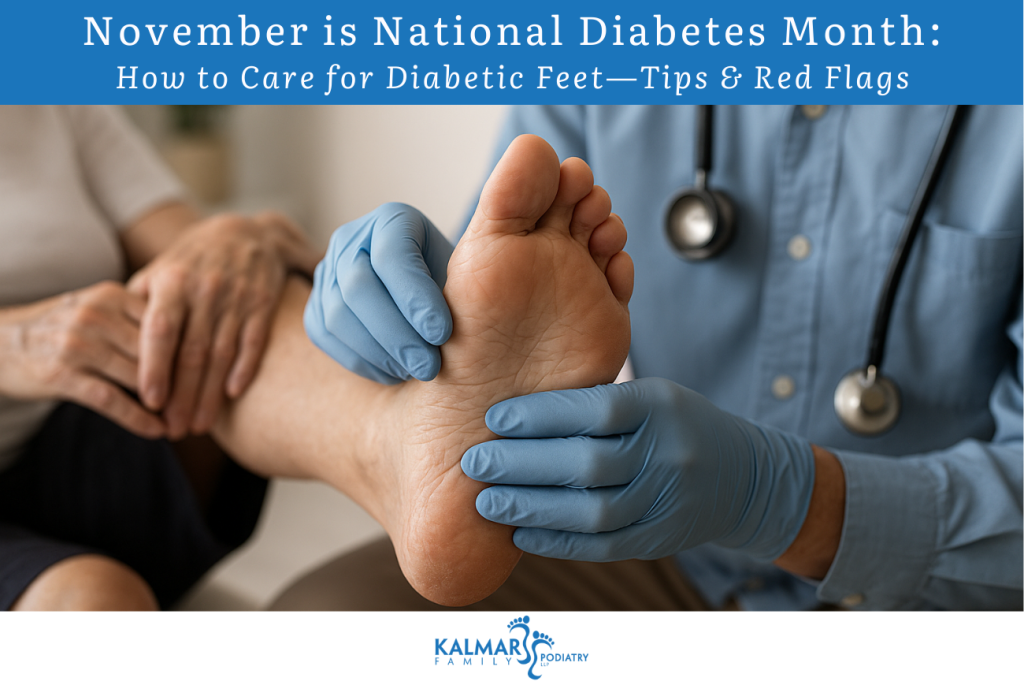
Why Diabetic Foot Care Is Essential
November marks National Diabetes Month, a reminder that people living with diabetes face a higher risk of foot problems. High blood sugar levels can damage nerves (neuropathy) and reduce blood flow, making it easier for small injuries to turn into serious complications. Proper daily foot care and regular podiatric visits are key to preventing infections, ulcers, and even amputations.
Daily Foot Care Tips for People with Diabetes
- Inspect Your Feet Every Day
- Look for blisters, cuts, redness, swelling, or nail changes.
- Use a mirror or ask someone to help you check the bottoms of your feet.
- Look for blisters, cuts, redness, swelling, or nail changes.
- Wash and Dry Carefully
- Use mild soap and warm—not hot—water.
- Pat dry thoroughly, especially between your toes.
- Use mild soap and warm—not hot—water.
- Moisturize Smartly
- Apply lotion to the tops and bottoms of your feet to prevent cracking.
- Skip the areas between the toes to avoid fungal infections.
- Apply lotion to the tops and bottoms of your feet to prevent cracking.
- Trim Nails with Care
- Cut straight across and gently file the edges to prevent ingrown toenails.
- If you have trouble seeing or reaching your feet, let a podiatrist handle nail care.
- Cut straight across and gently file the edges to prevent ingrown toenails.
- Wear Proper Footwear
- Choose shoes with cushioning and good fit; never go barefoot.
- Wear clean, dry socks that wick away moisture.
- Choose shoes with cushioning and good fit; never go barefoot.
- Schedule Routine Podiatry Visits
- Have a professional foot exam at least once a year—or more often if you have neuropathy, poor circulation, or a history of ulcers.
- Have a professional foot exam at least once a year—or more often if you have neuropathy, poor circulation, or a history of ulcers.
Red Flags to Watch For
Call your podiatrist immediately if you notice:
- Open sores, blisters, or wounds that do not heal
- Persistent redness, swelling, or warmth
- Skin discoloration, especially black or blue patches
- Sudden pain, numbness, or tingling
- Drainage or foul odor indicating infection
Early attention can prevent complications and protect your mobility.
Frequently Asked Questions
Q: How often should I see a podiatrist if I have diabetes?
A: At least once a year, but more frequently if you have neuropathy, poor circulation, or any history of foot ulcers.
Q: Can I prevent diabetic foot ulcers?
A: Yes. Daily inspection, proper shoes, and immediate treatment of even small injuries greatly reduce your risk.
Q: What if I find a small cut or blister?
A: Clean gently with mild soap and water, cover with a sterile bandage, and monitor closely. If there’s no improvement within 24 hours or you see signs of infection, contact a podiatrist.
Q: Are special shoes necessary for everyone with diabetes?
A: Not always, but diabetic shoes or custom orthotics can be helpful if you have foot deformities, frequent calluses, or poor circulation.
Q: Is foot pain normal for people with diabetes?
A: No. Pain, tingling, or numbness can indicate neuropathy or circulation problems and should be evaluated by a professional.
Contact Kalmar Family Podiatry
Protecting your feet is protecting your health. For expert diabetic foot care and preventive guidance, schedule an appointment today:
Kalmar Family Podiatry
📍 Address: 62 Green Street, Huntington, NY, 11743
📞 Phone: (631) 549-0955
🌐 Website: kalmarfamilypodiatry.com
This National Diabetes Month, take proactive steps to keep your feet healthy and strong.
